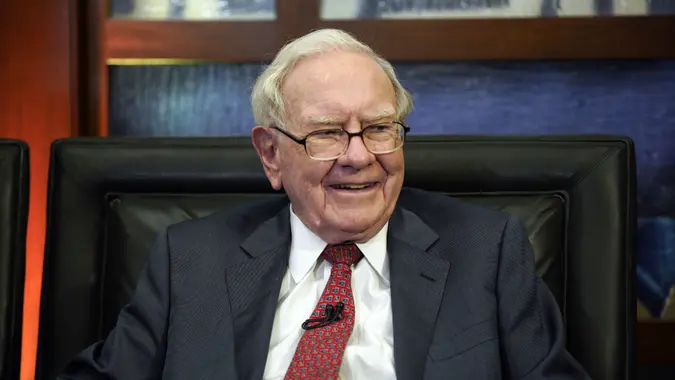The ‘Lazy Portfolio’ Method Could Be the Easiest Way To Become a Millionaire

Commitment to Our Readers
GOBankingRates' editorial team is committed to bringing you unbiased reviews and information. We use data-driven methodologies to evaluate financial products and services - our reviews and ratings are not influenced by advertisers. You can read more about our editorial guidelines and our products and services review methodology.

20 Years
Helping You Live Richer

Reviewed
by Experts

Trusted by
Millions of Readers
We all know it takes more than just saving if you want to become a millionaire. In order to build wealth, you also have to invest those savings over time, allowing you to take advantage of the power of compound interest and make money while you sleep.
Investing often conjures up images of complex strategies, constant monitoring of the stock market and high-stakes decisions, but it really doesn’t have to be that complicated. If you find the idea of managing your own investments too difficult or intimidating — or even if it just sounds really boring – then a “Lazy Portfolio” might be right for you.
What Is a Lazy Portfolio?
A lazy portfolio, as the name implies, is a simple and hands-off approach to accumulating wealth. The key principles of a lazy portfolio are diversification, low fees, and patience. Instead of actively building and managing a portfolio, you invest in a handful of low-cost index funds and hold onto them for the long term.
If you aren’t familiar with index funds, they are mutual funds or exchange-traded funds (ETFs) that attempt to replicate a specific benchmark, like the S&P 500. That doesn’t require a lot of judgment or energy, which means index funds charge extremely low fees.
For example, Vanguard’s S&P 500 ETF, which trades under the ticker VOO, has an expense ratio of only 0.03% — tiny compared to the industry average, which was 0.47% according to a report published by the Investment Consulting Institute. Low fees are important because they eat away at your returns, meaning you’ll have to save more or wait longer to reach your investment goals.
Building Your Lazy Portfolio
There’s no one perfect way to construct a lazy portfolio, but you do want to make sure you’re widely diversified, meaning your funds are made up of a large variety of different stocks and bonds. Diversification ensures your portfolio isn’t too risky and allows you to take advantage of whatever markets are doing well at any given time.
Jay Zigmont, PhD, Certified Financial Planner (CFP), and the founder of Childfree Wealth, said he typically recommends a simple 3 fund portfolio to his clients. The 3 funds are US stocks (total US stock market), international stocks (total international stock market), and bonds.
“It really can be that simple. You can buy an ETF for each of the three funds, set it and forget it.” said Zigmont. “Depending on how much risk you are willing to take, you can adjust the percent in bonds versus stocks. I tend to put about 20% of the total stock allocation in international stocks, but it is not an exact number.”
Customizing Your Lazy Portfolio
The only major decision you have to make for your lazy portfolio is your asset allocation — what percentage of your portfolio will be in stocks versus bonds.
For a long time, the conventional wisdom was to arrive at the percentage of stocks by subtracting your age from 100. So, if you’re 30 years old you would have a 70% allocation to stocks.
Life spans have gotten longer, though, and many experts now suggest that you subtract your age from 120 instead. A typical asset allocation for a lazy portfolio would be about 60% US stocks, 20% international stocks and 20% bonds.
If you want to be a little less lazy, you can get more creative with your fund choices. Maybe you want a fund that focuses on dividend stocks, or one that follows a specific index instead of the total stock market. It’s up to you.
“Personally, I follow a simple 3 fund strategy with a twist,” Zigmont advised. “The three funds I use are ESG funds (environmental, social, and governance) that cover the same three areas. When I have money to invest, I put money in each fund and don’t sell until I need the money again.”
What’s more important than the specific fund you choose is that it’s widely diversified and has low fees.
The Power of Compound Interest
The way a lazy portfolio makes you rich is through compounding over time. As you get a return on your money, you reinvest that return, essentially earning interest on top of your interest. Over time, the money you’ve made will keep making more money, eventually growing exponentially.
One famous example is a simple question: would you rather receive a million dollars right now, or a penny and double the amount every day for the next thirty days. If the million sounds like the obvious choice, think again — in 30 days that accumulated doubling will have compounded the penny into over $5 million.
The most important thing to know about compounding is that it takes time. In the penny example, the majority of that $5 million is created in the final three days. For a real world example, look at Warren Buffett: 99% of his net worth was accumulated after he turned 50 years old. A lazy portfolio can make you rich, but you’re going to have to be patient.
“You have a choice of your investments being simple or sexy. Sexy or fancy investing rarely beats simple, long-term, passive investing,” Zigmont said.
More From GOBankingRates
 Written by
Written by  Edited by
Edited by 

























